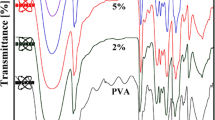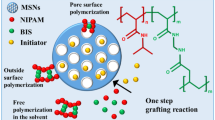Abstract
Organic–inorganic hybrid nanoparticles have been prepared by the direct facile esterification condensation under extremely mild conditions as ambient temperature, moisture and atmospheric pressure, and the resulting composite particles are characterized by ESCA, FTIR, TEM, DLS, TGA, DSC, and XRD techniques. Results show that this facile graft method has high graft efficiency and the grafted poly(ethylene glycol) (PEG) accounts for about 55 wt% of the total silica composites. The resulting silica nanoparticles have core-shell structure with PEG on the outside and SiO2 in the core. As a result, the dispersion behavior of nanoparticles and the thermal stability of the grafted PEG are improved by the formation of covalent ester bonds between PEG and the reactive silica nanoparticles. The PEG phase, however, is disturbed by the proximity of the oxide phase of SiO2. Consequently, less crystal or faulty crystal of PEG is resulted when PEG is grafted onto the surfaces of silica nanoparticles.









Similar content being viewed by others
References
Cruz AGB, Wardell JL, Rocco AM (2008) Hybrid organic–inorganic materials based on polypyrrole and 1,3-dithiole-2-thione-4,5-dithiolate (DMIT) containing dianions. J Mater Sci 43:5823–5836
Samuneva B, Kabaivanova L, Chernev G, Djambaski P, Kashchieva E, Emanuilova E, Salvado IMM, Fernandes MHV, Wu A (2008) Sol–gel synthesis and structure of silica hybrid materials. J Sol-Gel Sci Technol 48:73–79
Cheetham AK, Brinker CJ, McCartney ML (1996) Better ceramics through chemistry VII. Mater Res Soc Symp Proc 435:285–296
Dang TD, Chen JP, Arnold FE (1995) Hybrid organic–inorganic composites. In: Mark JE, Lee CYC, Bianconi PA (eds) ACS Symp Ser, vol 585. Am Chem Soc, Washington DC, pp 297–305
Lesot P, Chapuis S, Bayle JP, Rault J, Lafontaine E, Campero A, Judeinstein P (1998) Structural–dynamical relationship in silica PEG hybrid gels. J Mater Chem 8:147–151
Yoon TJ, Kim JS, Kim BG, Yu KN, Cho MH, Lee JK (2005) Multifunctional nanoparticles possessing a “magnetic motor effect” for drug or gene Delivery. Angew Chem Int Ed 44:1068–1071
Bourgeat-Lami E (2002) Organic–inorganic nanostructured colloids. J Nanosci Nanotechnol 2:1–24
Groll J, Amirgoulova EV, Amiringer T, Heyes CD, Rocker C, Nienhaus GU, Moller GU (2004) Biofunctionalized, ultrathin coatings of cross-linked star-shaped poly(ethylene oxide) allow reversible folding of immobilized proteins. J Am Chem Soc 126:4234–4239
Feng LB, Zhou SX, You B, Wu LM (2007) Synthesis and surface properties of polystyrene-graft-poly(ethylene glycol) copolymers. J Appl Polym Sci 103:1458–1465
Harris M (1997) Poly(ethylene glycol) chemistry. Biotech Biomed Appl. American Chemical Society, Washington DC, pp 16–21
Piehler J, Brecht A, Valiokas R, Liedberg B, Gauglitz G (2000) A high-density poly(ethylene glycol) polymer brush for immobilization on glass-type surfaces. Biosens Bioelectron 15:473–481
Butterworth MD, Illum L, Davis SS (2001) Preparation of ultrafine silica-and PEG-coated magnetite particles. Colloid Surf A 179:93–102
Dahmouche K, Santilli CV, Silva MD, Ribeiro CA, Pulcinelli SH, Craievich AF (1999) Silica-PEG hybrid ormolytes: structure and properties. J Non-Cryst Solids 247:108–113
Joubert M, Delaite C, Bourgeat-Lami E, Dumas P (2005) Hairy PEO/silica nanoparticles through surface-initiated polymerization of ethylene oxide. Macromol Rapid Commun 26:602–607
Bridger K, Vincent B (1980) The terminal grafting of poly(ethylene oxide) chains to silica surfaces. Eur Polym J 16:1017–1021
Xu H, Yan F, Monson EE, Kopelman R (2003) Room-temperature preparation and characterization of poly (ethylene glycol)-coated silica. J Biomed Mater Res A 66:870–879
Oh C, Ki CD, Chang JY, Oh SG (2005) Preparation of PEG-grafted silica particles using emulsion method. Mater Lett 59:929–933
Feng LB, Fang HX, Zhou SX, Wu LM (2006) One-step method for synthesis of PDMS-based macroazoinitiators and block copolymers from the initiators. Macromol Chem Phys 207:1575–1583
Feng LB, Gu GX, Chen M, Wu LM (2007) Synthesis and surface properties of poly(methyl methacrylate)/poly(ethylene glycol) binary brushes. Macromol Mater Eng 292:754–761
Hong CY, Li X, Pan CY (2007) Grafting polymer nanoshell onto the exterior surface of mesoporous silica nanoparticles via surface reversible addition-fragmentation chain transfer polymerization. Eur Polym J 43:4114–4122
Horr TJ, Reynolds GD (1997) The reactions of 3-glycidoxypropyltrimethoxysilane in acidic solutions on polymerization and in the presence of silica. J Adhes Sci Technol 11:995–1009
Tadokoro H, Chatani Y, Yoshiharo T, Nurahashi S (1964) Structural studies on polyethers, [-(CH-2)M-O-]N, 2. Molecular structure of polyethylene oxide. Makromol Chem 73:109–127
Acknowledgment
This work is supported by ‘Qing Lan’ Talent Engineering Funds by Lanzhou Jiaotong University, contract grant number: QL-08-03A.
Author information
Authors and Affiliations
Corresponding author
Rights and permissions
About this article
Cite this article
Feng, L., Wang, Y., Wang, N. et al. Preparation of poly(ethylene glycol)-grafted silica nanoparticles using a facile esterification condensation method. Polym. Bull. 63, 313–327 (2009). https://doi.org/10.1007/s00289-009-0089-0
Received:
Revised:
Accepted:
Published:
Issue Date:
DOI: https://doi.org/10.1007/s00289-009-0089-0




